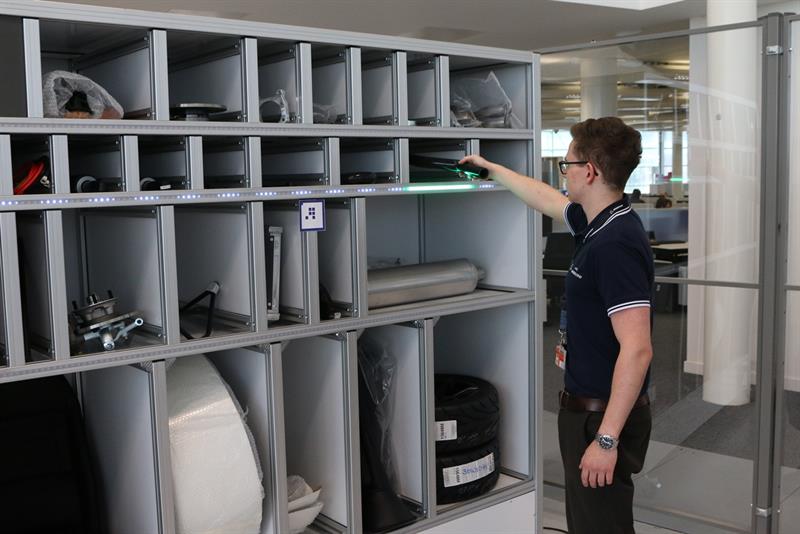With the rise of Industry 4.0, The AMRC’s latest output is Factory 2050, the UK’s first purpose built smart factory. This state of the art facility is dedicated to conducting collaborative research into reconfigurable digitally assisted assembly, component manufacturing and machining technologies. The factory itself is capable of being rapidly reconfigured to house projects from different industries, all with the goal of ushering Industry 4.0 technology into manufacturing.
“We currently have 107 members, comprising two levels,” explains Stuart Dawson, AMRC’s CTO. “Tier 1 members that contribute £200,000 per year, either in cash or in benefits in kind into the AMRC, and tier 2s who contribute £30,000.”
Two thirds of this money is used for direct research that is of, ‘particular interest to those companies’, and the remaining third goes into a separate ‘pot’, where the members can vote for what kind of research themes the funds should be spent on.
Dawson adds: “The idea is that your contribution results in access to many multiples of the amount you’ve invested through membership.”
It’s not just multi-nationals with access to this kind of capital to spend on R&D that Factory 2050 caters for, however. Although it works with the likes of Boeing, Airbus, Rolls-Royce and BAE Systems, the work done here can benefit – and has benefited – SMEs and non-members. In fact, many of the projects currently housed at Factory 2050 are doing just that.
 Meggitt – a supplier of complex parts to the aerospace industry – along with the Aerospace Technology Institute, MTC, IBM and Cranfield University all came together and became involved in a £5m project to develop sensing and automation technologies to improve the production of low volume, manual build assembly cells. The Meggitt Modular Modifiable Manufacturing, or M4, uses sensors, LEDs and optical systems to ensure that operators are picking and packing the correct components, which are then delivered to smart workbenches via autonomous transporters. The smart workbenches weigh the kits to ensure all the correct components are there and use a combination of laser sensor measurements and even digital twin CAD models to make sure the operator assembles the components in the correct order and to the correct tolerances.
Meggitt – a supplier of complex parts to the aerospace industry – along with the Aerospace Technology Institute, MTC, IBM and Cranfield University all came together and became involved in a £5m project to develop sensing and automation technologies to improve the production of low volume, manual build assembly cells. The Meggitt Modular Modifiable Manufacturing, or M4, uses sensors, LEDs and optical systems to ensure that operators are picking and packing the correct components, which are then delivered to smart workbenches via autonomous transporters. The smart workbenches weigh the kits to ensure all the correct components are there and use a combination of laser sensor measurements and even digital twin CAD models to make sure the operator assembles the components in the correct order and to the correct tolerances.
Meggitt needs this system because – along with many engineering and manufacturing companies – it has an aging workforce and is struggling to fill the skills gap with young engineers.
Diego Aranda, systems technical lead at AMRC, says: “When those guys retire that knowledge is lost. With M4 that knowledge will be retained by the system. You also make your operators multi-functional, so they can assemble any component parts because all the information they need for any assembly is provided to them by the system.”

The picking technology developed for the M4 project has also been utilised by another project at the AMRC. The Reconfigurable Assembly Integrated Design (RAID) project aims to utilise different assisted assembly techniques – from cobots to augmented reality – to build a Caterham Seven kit car in order to compare the build time and advantages of each technology. Caterham was not a partner of the RAID or M4 projects but, through selling its car to the AMRC has built up a small partnership with the AMRC and could stand to benefit from both. For example, the M4 smart picking system, which costs around £3,000 rather than roughly £25,000 a bespoke one would cost, could be implemented in its own manufacturing facilities.
This is the case throughout Factory 2050. For example, one manufacturer of low-value construction tools benefits from automation technologies developed by AMRC so that its engineers can upskill to less repetitive, high-value tasks.
Also, nestled among large additive and subtractive manufacturing machines, and industrial robots carrying out advanced aerospace applications, sit two ‘Industry 2’ (pre-automation) machines: a Bridgeport milling machine and a Colchester Bantam lathe. These machines, which represent the machinery used by a number of UK SME manufacturers, now have the potential to be retrofitted with Industry 4.0 technology.
The Colchester lathe, for example,is fitted with £500 of sensing equipment from Texas Instruments measuring information like spindle rpm, vibration, temperature and humidity. The Bridgeport features a more accurate £1000 suite of sensors from National Instruments that connects to PTC’s Thingworx platform to create detailed information about how the machine is operating.
These sensing techniques can also provide insight into predictive analytics, which can help operators to undertake maintenance on the machine before it breaks down.
Paul Haimes, VP, business development and technical sales at PTC, says: “This is how, as a small to medium size business in the supply chain, IoT becomes relevant to you at a price point that makes sense. You’ve got understanding of what your machines are doing, and you can also add value in the supply chain. These two old machines are hugely significant for what they now do.”
Haimes also highlights his concern about the UK’s slow uptake of automation technology, generally.“We’ve got to get on board with Industry 4.0,” he says. “The UK, as a manufacturing nation, has the lowest percentage of robots on the shop floor of any developed European nation.”
This view is shared by Dawson, who adds: “Despite the UK having a world class university system, we’re consistently third in the world, behind the USA and China, in terms of academic output. We fail to commercialise a lot of the ideas that come out of the academic base.”
The work has already resulted in securing jobs and re-shoring work to the UK, which is what Factory 2050 aims to address: the price point of Industry 4.0 technology to UK industry.











